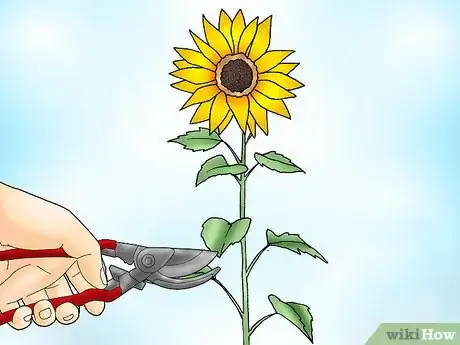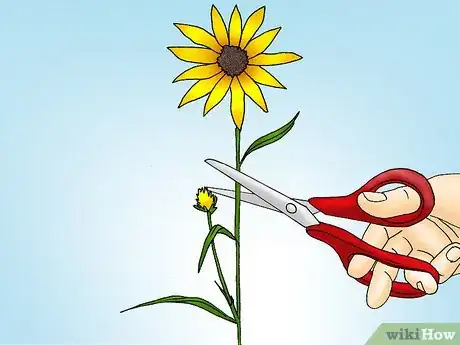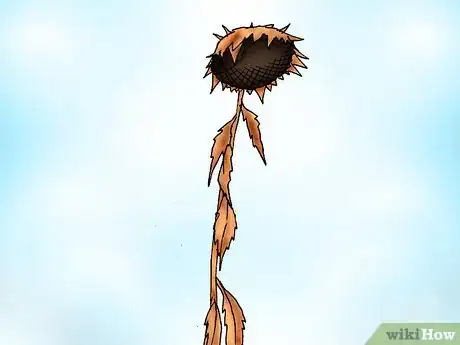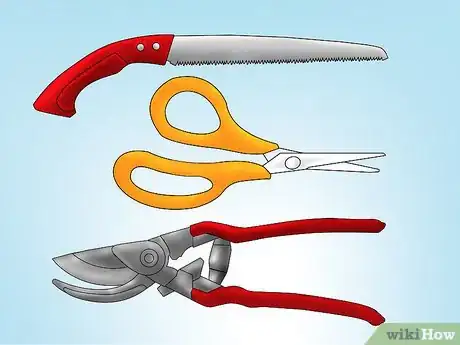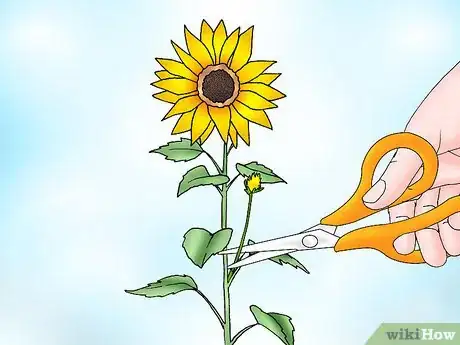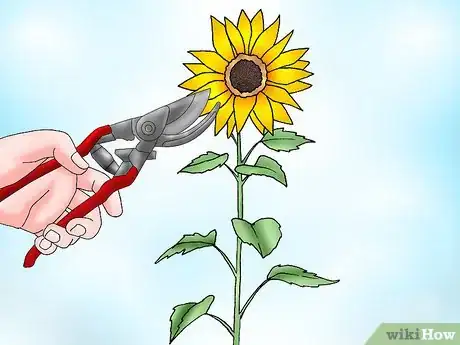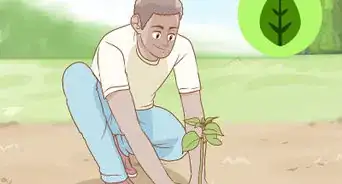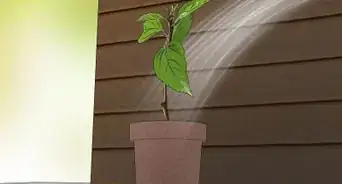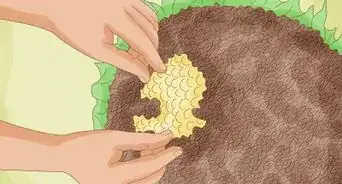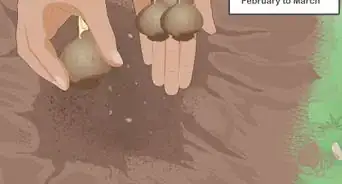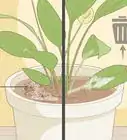This article was co-authored by Monique Capanelli. Monique Capanelli is a Plant Specialist and the Owner and Designer for Articulture Designs, an innovative design firm and boutique in Austin, Texas. With over 15 years of experience, Monique specializes in interior botanical design, living walls, event decor, and sustainable landscape design. She attended the University of Texas at Austin. Monique is a Certified Permaculture Designer. She provides plant and botanical design experiences, from small gifts to entire transformations, to shoppers as well as commercial clients including Whole Foods Market and The Four Seasons.
wikiHow marks an article as reader-approved once it receives enough positive feedback. In this case, several readers have written to tell us that this article was helpful to them, earning it our reader-approved status.
This article has been viewed 197,948 times.
Annual sunflowers (plants that only bloom once) typically do not need any pruning. However, sunflowers that are growing in groups may need to be trimmed to keep from knocking one another over. By comparison, perennial types of sunflowers will occasionally require a trim. Pruning helps these plants maintain a neat and tidy appearance during the summer months when they tend to get unruly. To prune your plants correctly, you will first have to know when to prune them.
Steps
Knowing When to Prune
-
1Cut your perennial plants back twice a year. A good general rule for pruning perennial sunflowers is to cut them down to half their size in the late spring or early summer. Then, reduce their size again by a third in June or July.[1]
-
2Keep your warm climate in mind. Gardeners from warmer climates should prune Maximillian, swamp (Helianthus angustifolius), and willow leafed (Helianthus salicifolius) sunflowers to two-thirds of their original height in June.[2]
- This procedure will keep these potential giants at a more manageable size and eliminate the need to stake them.
Advertisement -
3Avoid pruning after the first blooms appear. Most perennial sunflower species bloom between mid and late summer. Gardeners should keep an eye on their plants at such times and refrain from pruning them after their buds start forming.[3]
- However, the rules are slightly different for late summer blooming varieties. Late summer blooming types should be pruned back when they reach between 1.5 to 2 feet (0.5 to 0.6 m) in height, because they will recover in a few weeks and bloom regardless of the cuts.
-
4Prune very tall varieties of sunflowers in June or July. Maximilian sunflowers (Helianthus maximiliani) and Mexican sunflowers (Tithonia diversifolia) should be trimmed in June or July. This will reduce the sunflowers’ size from their typical height of 9 feet (2.7 m) or greater to a much more manageable 4 feet (1.2 m).[4]
- Maximilian sunflowers can also be left standing through the winter months as food for the birds. If you choose to leave your tall sunflowers for the birds, they can be cut to the ground in the early spring to prepare the plant for new growth.
-
5Know that your annual flowers will not bloom again. Annual sunflowers can be trimmed back to the ground when they start to dry out and turn brown. They will not bloom again so many gardeners choose to remove them from their gardens entirely.
Pruning Your Sunflowers
-
1Sterilize all pruning equipment prior to use. Sterilizing your pruning equipment is particularly important if you have dealt with some diseased plant parts recently. This will prevent any lingering bacteria or germs from unintentionally being spread throughout the garden.
- Prune sunflowers with sharp bypass hand pruners or hedge shears.
-
2Trim away unhealthy parts of the plant first. Trim any sick, weak, damaged, crossing, or dead branches off of your plant before starting into any sort of heavy pruning operation.[5]
- Diseased parts should be kept out of the compost bin to prevent the ailment in question from being transmitted to any other plants. These bits of debris will instead need to be burned or bagged up and left for the local waste crews to collect.
-
3Prune your perennials so that they take on the desired shape. Once you have cut away all of the unhealthy branches, you can choose to prune your perennial sunflowers for shape.[6]
- Some people prefer to only prune away damaged parts of the plant so that their sunflowers can take on a more wild look.
-
4Water your plants after you prune them. Water the sunflowers regularly after pruning to help them recover from the stress of being trimmed back. Give them enough water to thoroughly soak the soil every time the top inch of the soil becomes dry.
Expert Q&A
-
QuestionHow do I prune a tree?
 Monique CapanelliMonique Capanelli is a Plant Specialist and the Owner and Designer for Articulture Designs, an innovative design firm and boutique in Austin, Texas. With over 15 years of experience, Monique specializes in interior botanical design, living walls, event decor, and sustainable landscape design. She attended the University of Texas at Austin. Monique is a Certified Permaculture Designer. She provides plant and botanical design experiences, from small gifts to entire transformations, to shoppers as well as commercial clients including Whole Foods Market and The Four Seasons.
Monique CapanelliMonique Capanelli is a Plant Specialist and the Owner and Designer for Articulture Designs, an innovative design firm and boutique in Austin, Texas. With over 15 years of experience, Monique specializes in interior botanical design, living walls, event decor, and sustainable landscape design. She attended the University of Texas at Austin. Monique is a Certified Permaculture Designer. She provides plant and botanical design experiences, from small gifts to entire transformations, to shoppers as well as commercial clients including Whole Foods Market and The Four Seasons.
Plant Specialist You should remove the dead parts of the tree and cut the branches that have grown too long and are spoiling the shape.
You should remove the dead parts of the tree and cut the branches that have grown too long and are spoiling the shape. -
QuestionWhat is the advantage of pruning the trees?
 Monique CapanelliMonique Capanelli is a Plant Specialist and the Owner and Designer for Articulture Designs, an innovative design firm and boutique in Austin, Texas. With over 15 years of experience, Monique specializes in interior botanical design, living walls, event decor, and sustainable landscape design. She attended the University of Texas at Austin. Monique is a Certified Permaculture Designer. She provides plant and botanical design experiences, from small gifts to entire transformations, to shoppers as well as commercial clients including Whole Foods Market and The Four Seasons.
Monique CapanelliMonique Capanelli is a Plant Specialist and the Owner and Designer for Articulture Designs, an innovative design firm and boutique in Austin, Texas. With over 15 years of experience, Monique specializes in interior botanical design, living walls, event decor, and sustainable landscape design. She attended the University of Texas at Austin. Monique is a Certified Permaculture Designer. She provides plant and botanical design experiences, from small gifts to entire transformations, to shoppers as well as commercial clients including Whole Foods Market and The Four Seasons.
Plant Specialist Pruning helps to maintain the shape and size of a tree. It also stimulates fuller growth.
Pruning helps to maintain the shape and size of a tree. It also stimulates fuller growth. -
QuestionOne sunflower plant has five blossoms. Should I prune down to only one or two?
 Community AnswerYou can if you'd like, but you may also leave all five there.
Community AnswerYou can if you'd like, but you may also leave all five there.
Warnings
- Gardeners should be careful when they go to prune their plants because annual sunflowers that are cut will not produce new blooms.⧼thumbs_response⧽
References
- ↑ https://gardenerspath.com/how-to/pruning/fall-spring-perennial-cutbacks/
- ↑ https://www.ftd.com/blog/design/sunflower-care
- ↑ http://www.almanac.com/plant/sunflowers
- ↑ http://masterofhort.com/2011/11/maximilian-sunflowers-helianthus-maximiliani/
- ↑ https://www.youtube.com/watch?v=ZoW-SAmmodw
- ↑ Monique Capanelli. Plant Specialist. Expert Interview. 22 September 2020.
About This Article
Whether or not you need to prune your sunflowers depends on what kind they are. Annual sunflowers, or sunflowers that only bloom once, usually don’t need to be pruned at all. Perennial sunflowers that grow back every year can be pruned to maintain a more manageable height and neater appearance. A good rule of thumb is to prune them back to half of their size in late spring or early summer, and then cut them back by about a third in June or July. However, avoid pruning your perennial sunflowers once the buds start forming so you don’t stop them from blooming. You should also prune away any dead or damaged growth on your perennials throughout the growing season. If you want your sunflowers to have a neater appearance, you can also prune them to your desired shape. Remember to always sterilize your pruning shears beforehand so you don’t spread any diseases to your sunflowers. For more help, including how to cut off sunflowers for a bouquet, read on!
